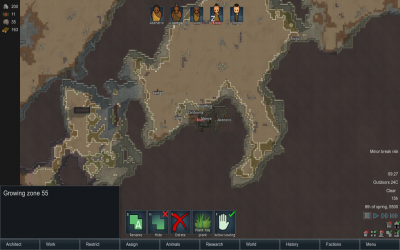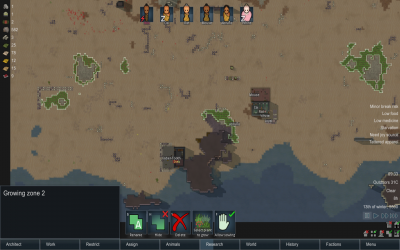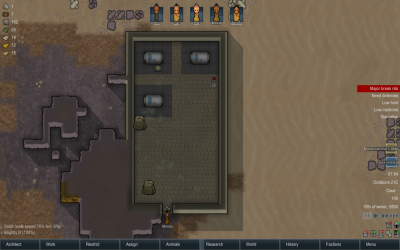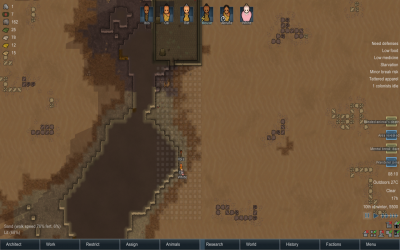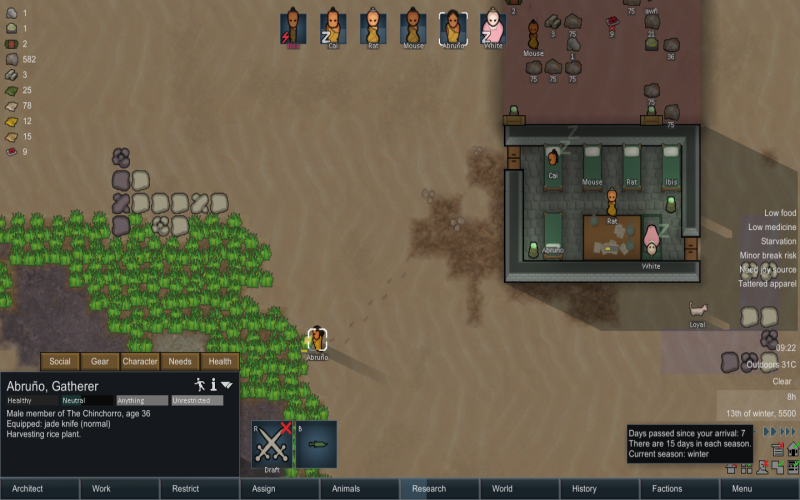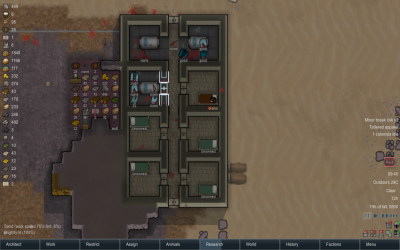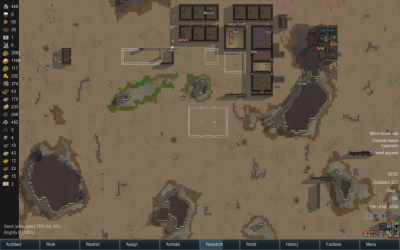Extreme Desert Guide
Template:Tocright This guide details how to survive in one of the most hostile environments in Rimworld - an extreme desert.
Brief
Extreme deserts are even hotter than a regular desert. Temperatures can be reach high enough to cause heatstroke for colonists not dressed for hot weather.
Plants are scarce in an extreme desert, and there is a lack of fertile soil to grow your plants in. Even in deserts there are still small parches of arable land, however in an extreme desert all you have are the gravel patches surrounding rocks.
Starting area
You must select the terrain type wisely; there are four: Flat, Small Hills, Large Hills, and Mountainous.
- Flat maps will have growing zones scattered but still oasis shaped while high altitude maps will have growing areas at the foot of the mountains stretching thin and extensively across one end to the other which means you will need to cover a large portion instead of just one compacted space.
- Flat maps are also likely to have more moving meat like Dromedary, Fennel foxes and Iguanas. Foxes are the only threat present when hunting. And of course some Megascarab which while slow, they hit hard and it's best to gather everyone against a single target than just one hunter. Mostly because having wounded members at the very beginning will pin your progress.
- Coastal flat maps will have reduced buildable area due to water cover and there's no algae or fish, just aesthetics.
Lost Tribe
- Main Article: Scenario system - Lost tribe
- Find the closest structure that can fit five characters without having to use much of the starter 500 wood for nothing else than beds and maybe some gap filling for open walls and a door.
- Set priorities for all to construct and mine. Compared to other biomes, due to the harsh circumstance here, you may do better by building production benches altogether than each with their own space.
- The 300 pemmican will not last past a day and you will need to hunt anything that there is, and build a butcher's table. You may find just one agave plant but at five percent growth which is useless. Thanks to the high temperature and lack of berries, you will likely have to sacrifice your bonded pets. Meat rots away in a couple of days, so don't go hunting eagerly, keep animals alive until you need them.
- Immediately start growing rice or you won't make it past a week.
- Begin building benches, the most common resolve is to use wood as primary material, but everything can actually be made of other resources as well such as steel. It is important to save as much wood as you can for passive coolers instead, which is the only commodity available at early stage to relieve your characters from high temperatures. Keep your wood reserve only for special occasions and not just all the time with little benefit. Certainly, anybody would prefer to feed people with cooked food, but the use of the little wood available at the start will run out fast, they just need to eat. So wait until you get the electric stove running to provide warm meals.
- Research: If playing a flat map, stonecutting will be your resource to build walls. And if playing mountainous maps, start caving in by mining and you can go straight for electricity.
- The very first visitor will be your savior as will be bringing some pemmican, but with just 200 starter silver, you can only buy like 55 units which isn't much or 60 if selling the spare weapon.
Food
Immediately start growing rice or you won't make it past a week. Rice is not a good choice of crop in poor soil, but they grow fast. Once you have decent food stocks, replace this with potatoes as they perform better in poor soil.
Somewhere around your fifth day, your colony will have no food available at all and your only chance for survival will be opening an ancient shrine and hope there is at least one hive that has a spelopede or megaspider to hunt. These creatures will chase any intruder up to some 30 tiles away from their hive so they won't chase you forever, but they are very fast. Since you only start with two short bows and a bundle of pila, it is still possible to hunt without harm but will require good concentration and familiar tactic knowledge of kitting. To kite, means having a fast bait run towards a direction where nobody else is, while at the same time, the others shoot at the chasing creature. Use the Plan grid to draw their attack range.
If you are lucky, the same moment you need to open the ancient shrine will coincide with the timing of your first newcomer who might be better equipped to hunt, most likely a pistol. Which means you can go to up a max of four hunters. One more mouth to feed but safer hunting. The newcomer may likely as well arrive with some packaged survival meal, but it won't be enough for more than a day.
Insect jelly will start spawning, which will become another nutritional source, and this one never rots. But, hives will live so long as there is a guardian keeping maintenance, and if you kill them all, they will stop producing jelly. Soon after, by the time you might be picking them up. Glow pods will appear too, replacing torch lamps.
Check your rice plantation periodically, as the plant can be harvested as early as 66% growth. While it may not yield much food, it's still better than nothing.
Check on the few agaves, they may be ready for harvest by now.
Check if any other life form has ventured to your territory.
Reached your first 100% ready harvest? Congratulations, you made it!
Gathering materials
Now that our bellies are full, it's time to continue colony development. If in flat map and researching stonecutting, there will be need of wood to build the bench (75 units) which can be obtained by cutting down Saguaro cactus that provide merely 13 wood. And like it or not, a horseshoe pin to relief people as you may have seen them going on mental breaks way too often, specially if there's tribe members with addictions, so another 15 woods there. Craft stone blocks.
Those in high elevation areas should start caving in. During this process you may likely strike other minerals, which are slower to mine. But their empty space will do better for laying out a proper cave system, otherwise you will find yourself mining too much when going after said minerals gaining more work afterwards with the increasing need to build walls where those minerals were located to avoid mountain roof collapse.
Remember that ancient shrine? That room can also be used to build more facilities.
Continuing research
Did you notice winter temperature is around 30 Celsius? Imagine peak summer time. Double time on research to get electricity. Lucky if you have a night owl in the team.
Summer
Summer is going to start soon, and while the season itself is not a threat, heat wave is as it rises temperature up to 60 degrees Celsius. You will need to build passive coolers which require 50 wood each. Chopping cactus even at 100% growth will not be enough. So what you can do is to deconstruct the wooden beds you built earlier, to salvage some wood; and later on build beds of stone instead. Just so that your colony doesn't die of heatstroke. Any temperature below 30 degrees Celsius will allow your people to recover at night. Walls and doors made of wood will do as well, but not the benches, except maybe for the butcher's as you won't be so dependent on meat with all the harvest ready.
Base relocation or upgrade
After you have gone past your first heatwave, it's time to make life more comfortable so that none of your people are psychologically nor emotionally disturbed. Try to make the most of the whole map with as less effort as possible. And the rest it's up to you. Good luck!
